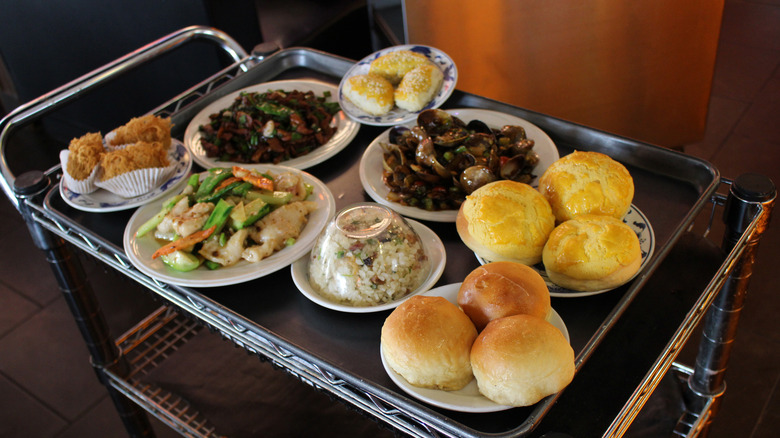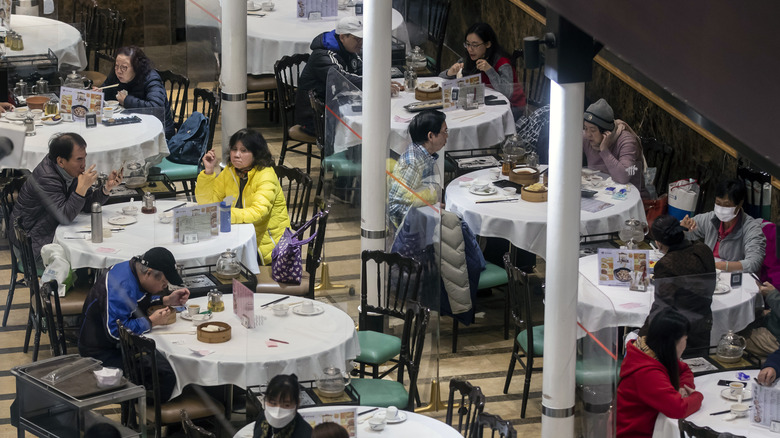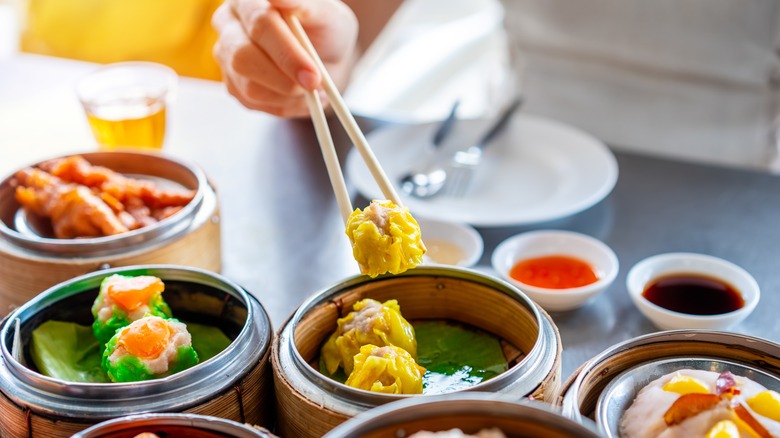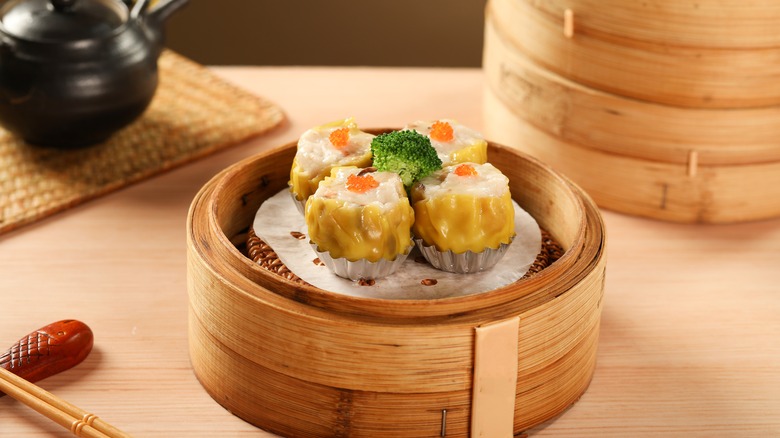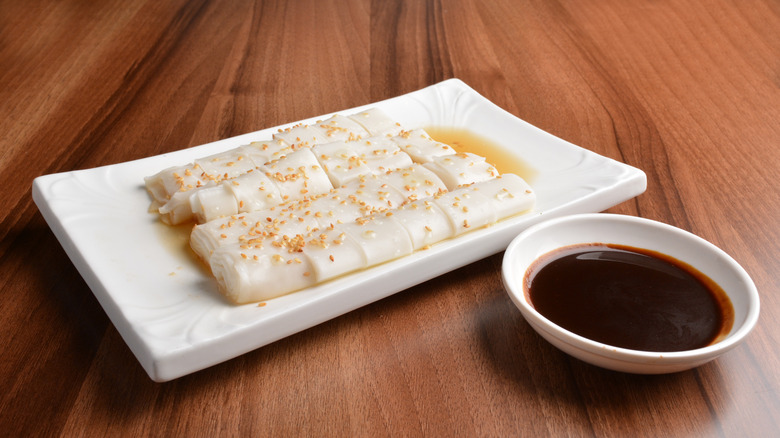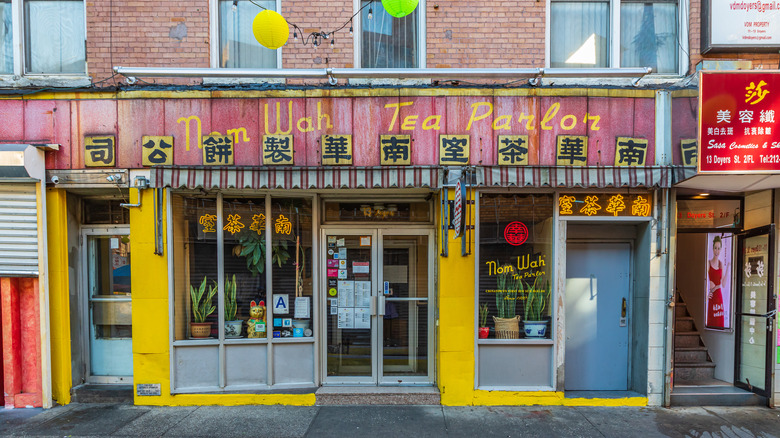What Is Dim Sum And How Do You Navigate A Typical Menu?
Hailing from southern China, dim sum — essentially a meal made up of a bunch of small plates — is an iconic part of food culture in areas like Guangdong province and Hong Kong. The name means "touch the heart," and refers obliquely to the fact that the dishes aren't meant to fill you up, but instead function more like a collection of lighter snacks, although it's actually quite easy to fill up at dim sum. There's a long list of dishes you might encounter, but you should expect an array of dumplings, buns, rolls, and more. It's often served in large banquet hall-type restaurants, where servers push around carts stacked with bamboo steamer baskets holding a selection of dishes from a restaurant's menu.
Dim sum is traditionally seen as a brunch type of meal eaten in the late morning to early afternoon hours, but some restaurants do serve it at other hours, like dinnertime. It's sometimes referred to as "yum cha," which means "drink tea" in Cantonese, so tea is fittingly a big part of the meal — you'll usually get a refillable teapot for the table, often with pu'er or oolong tea. There's some debate as to whether yum cha and dim sum are exactly the same, but they're generally regarded as very similar meals.
The history of dim sum
Dim sum first cropped up in tea houses along the Silk Road in southern China. As travelers passed through, either heading west or on their way to southeast Asia, tea houses started serving small dishes to travelers. The focus was on dishes that could be made in bulk and doled out to customers as they passed through.
It's not clear exactly how long this practice has been around. Some sources say that some version of dim sum originated around 2,500 years ago, while some others place it closer to 1,000 years ago, but it's generally agreed that it was a meal served to traveling businessmen in southern teahouses. Royal kitchens in China later caught onto the idea, making dim sum recipes into quite the art form, although their recipes still originated from street vendors. Cantonese immigrants to the U.S. brought dim sum with them, with the first restaurant considered to have opened in San Francisco in 1920. These restaurants catered mostly to Chinese diners, but from the 1950s onwards, began to get more traction outside of Chinese communities in cities like New York, leading to dim sum being a mainstream Chinese meal nowadays.
How to order dim sum
If you head to a dim sum restaurant, there are two possible ways you'll order. Many dim sum restaurants have servers pushing carts around the restaurant — you can decide what you want based on what's on the cart, and a server will typically mark a card on the table to indicate what you ate (for the purposes of adding up the check later). In some dim sum restaurants, you may be given this card (which will list the dishes available) for you to mark with the orders for the table.
If you're ordering from the carts, know that each cart will usually have a small selection of the entire menu on it. So, don't go crazy ordering everything from one cart (unless the whole cart appeals to you, of course) — more of them will pass by with different choices. If you're playing it smart, you may want to look out for carts coming out of the kitchen — chances are they'll be loaded with the freshest food in the room.
Tea will often be provided to you in the form of a communal pot for the table — the tea is bottomless, but you'll need to signal for a refill. Usually this is done by turning the lid upside down in the pot, or taking the lid out — the servers should stop to fill it back up with hot water.
Dim sum dishes you should know about
Dim sum restaurants offer a wide range of dishes, with various dumplings, steamed buns, rolls, and more. In terms of dumplings, you'll often encounter siu mai or shumai, a cylindrical-shaped steamed dumpling with an open top often filled with a mix of shrimp and pork. Soup dumplings, called xiao long bao, are another favorite: They have a thicker skin and a conical shape that's pinched together at the top to hold the dumpling together. The filling is both pork meat and broth — be careful not to burn yourself on the hot liquid. Then there's har gow, a shrimp dumpling with a starchy, translucent skin and larger pieces of shrimp inside (as compared to dumplings that have ground meat).
When it comes to buns, expect pork. The classic is cha siu bao, a fluffy and bready steamed bun that's larger and filled with sweet and sticky barbecue pork. While perhaps not quite as common, you may encounter baked versions of these buns: They have an exterior that's more brown than white and a bit crispy, with the same filling.
More dim sum dishes: Rolls, desserts and more
Dumplings and buns aren't all there is to dim sum. Rolls are another common item — for example, cheong fan, a flat piece of rice paper or a large rice noodle that's often wrapped around a beef or shrimp filling and served with a sweet soy sauce. Classic spring rolls also sometimes crop up on dim sum menus.
Dim sum is a pretty meat-heavy affair; beyond dumplings and rolls, beef spare ribs with black bean sauce or beef meatballs are also dim sum standards. For some vegetables, don't look past turnip cakes, a savory square made with rice flour and daikon radish (this means they're sometimes called radish cakes on menus) — but vegetarians should know they often contain shrimp or sausage.
This meal isn't all savory — there are always some sweet treats at dim sum, like sesame balls, made with rice flour coated in sesame seeds. They're filled with red bean paste and deep-fried. There are also Hong Kong-style egg tarts, made with a flaky pastry filled with a bright yellow egg custard — they're descended from British custard tarts, which colonizers brought to Hong Kong (there's also a separate Macau-style egg tart that's closer to the Portuguese style pastéis de nata).
Some of America's most famous dim sum spots
Although dim sum has gained popularity beyond the Chinese communities of the United States, you'll still find some of the biggest, best, and most famous dim sum halls in big city Chinatown districts, such as the iconic Chinatowns of New York and San Francisco. In San Francisco, you'll find Hang Ah Tea Room, considered the oldest dim sum restaurant in the country. Its dining room may not be flashy, but it serves all the dim sum staples and is still independently run.
In New York City, consider stopping by famed places like Jing Fong — while it was once the city's largest Chinese restaurant, seating over 800, COVID-19 forced this palatial dim sum hall to shutter. It later reopened in a much smaller space, but with the same deep red furnishings and all the delectable dim sum staples. Similarly famous is Nom Wah Tea Parlor, also in New York, which is the city's longest-open Chinese restaurant. This slice of Manhattan history also serves all the classics, and now has a Philadelphia location, too.
